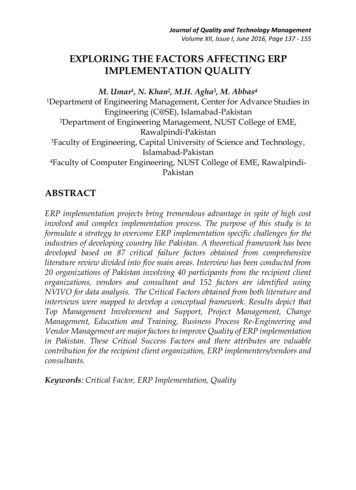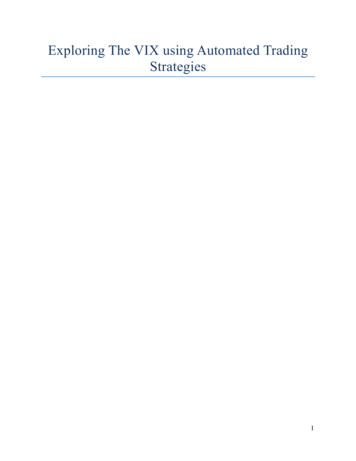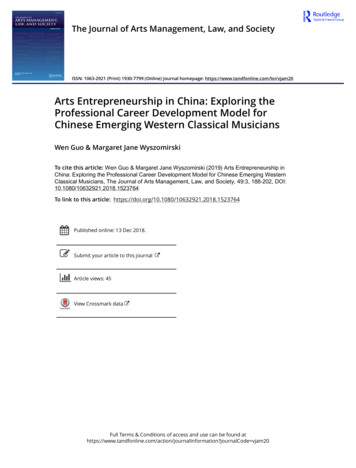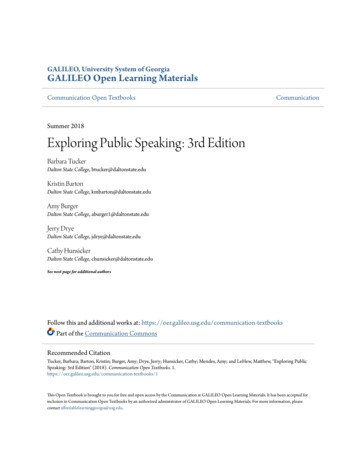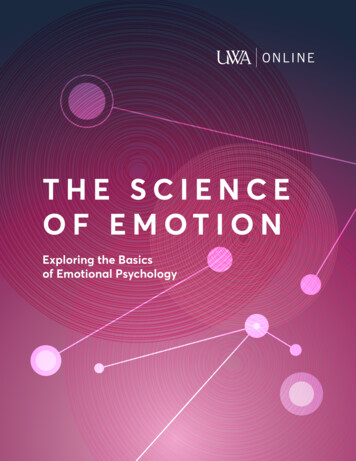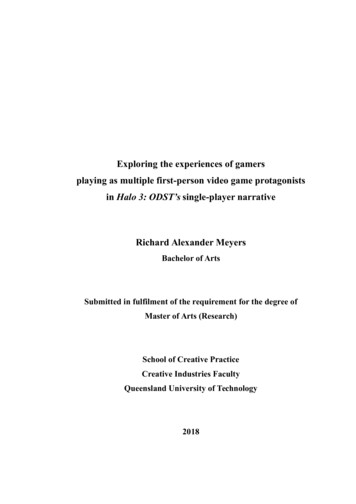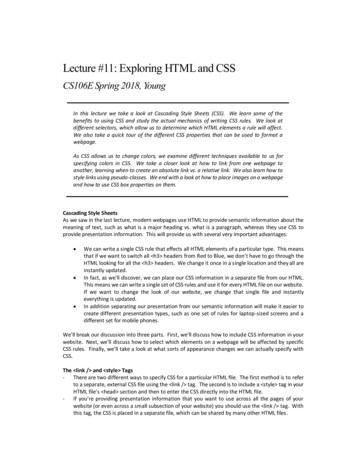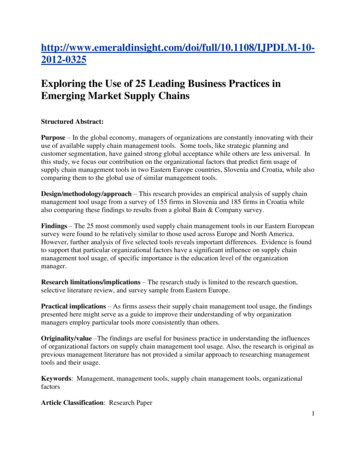
Transcription
DLM-102012-0325Exploring the Use of 25 Leading Business Practices inEmerging Market Supply ChainsStructured Abstract:Purpose – In the global economy, managers of organizations are constantly innovating with theiruse of available supply chain management tools. Some tools, like strategic planning andcustomer segmentation, have gained strong global acceptance while others are less universal. Inthis study, we focus our contribution on the organizational factors that predict firm usage ofsupply chain management tools in two Eastern Europe countries, Slovenia and Croatia, while alsocomparing them to the global use of similar management tools.Design/methodology/approach – This research provides an empirical analysis of supply chainmanagement tool usage from a survey of 155 firms in Slovenia and 185 firms in Croatia whilealso comparing these findings to results from a global Bain & Company survey.Findings – The 25 most commonly used supply chain management tools in our Eastern Europeansurvey were found to be relatively similar to those used across Europe and North America.However, further analysis of five selected tools reveals important differences. Evidence is foundto support that particular organizational factors have a significant influence on supply chainmanagement tool usage, of specific importance is the education level of the organizationmanager.Research limitations/implications – The research study is limited to the research question,selective literature review, and survey sample from Eastern Europe.Practical implications – As firms assess their supply chain management tool usage, the findingspresented here might serve as a guide to improve their understanding of why organizationmanagers employ particular tools more consistently than others.Originality/value –The findings are useful for business practice in understanding the influencesof organizational factors on supply chain management tool usage. Also, the research is original asprevious management literature has not provided a similar approach to researching managementtools and their usage.Keywords: Management, management tools, supply chain management tools, organizationalfactorsArticle Classification: Research Paper1
2
1.IntroductionIn the competitive global environment, organizations can only achieve long term survival throughcontinual improvement (Jennings, 2005; Hartley, 2007; Daft, 2009; Martin, 2009). Therefore,organizations are constantly innovating in their use of management tools. Management tools mayinclude a variety of techniques firms utilize in managing their organization. Tools such asstrategic planning, benchmarking, and total quality management are among the most commonlyused in many firms around the world (Rigby and Bilodeau, 2007) and represent some of theleading business practices in firm supply chains. However, the utilization of modern managementtools come from a long history in the content-related development of management as a scientificdiscipline which includes many distinct phases, i.e. Classical, Humanistic, Systems, Contingency,Post-modernistic, and the Scientific Values (Galbraith, 2002; Hatch, 2006; Linstead et al., 2009;Lafley and Johnson, 2010; Mullins, 2010). In each phase, researchers developed numerousexplanations in reference to the meaning of an abstract or generic management idea (Lock, 1992;Cole, 2004; Armstrong, 2006; Daft, 2007; Certo and Certo, 2009).Specifically, this study aims to review how organizations use management tools for thebetterment of their supply chains. Supply chain management involves the integration of differentinternal functional areas with parties outside the firm. Through supply chain management,suppliers, customers, and third-party providers share information in an effort to make the channelmore efficient and thus competitive (Ellram and Cooper, 1990). Supply chain management toolsare the means by which the organization pursues the integration requirements of supply chainmanagement and the adoption of supply chain management-enhancing tools have a positiveimpact on firm value and investors (Filbeck et al., 2005). Even firms engaging in minimum levels3
of supply chain management realize the importance of exchanging quality information at superiorspeeds with channel members (Fawcett and Magnan 2002). Supply chain management tools mayassist firms in pursuit of information integration through such tools as strategic planning,knowledge management, strategic alliances, etc.While some global aspects of management tool usage have been examined (Rigby andBilodeau, 2007; Rigby and Bilodeau, 2009; Rigby, 2011), they are limited to main geographicregions, excluding new members of the European Union. Thus, new European countries, such asSlovenia and Croatia, formerly a part of Yugoslavia, are excluded from those surveys. Our studyinvestigates the state of supply chain management tool usage in new European countries – i.e.former transition economies moving from government-planned economy to free market economy,which has previously not been attempted in the literature. Slovenia joined the European Union in2004 and Croatia will join on July 1st, 2013.The term management is subject to many interpretations (Chandler, 1996; Black, 1997;Cooper and Argyris, 1998; Gove, 2002; Wren, 2004; Daft, 2005; Schermerhorn, 2009) withnumerous concepts attributed to the meaning of management and the work of managers. Inmodern theory and the practice of management, complexity is ever increasing which generatesnew dilemmas for researchers around understanding the need for, and benefits received from theuse of management tools. (Etzioni, 1997; Schermerhorn and Chappell, 2004; Hitt et al., 2008;Certo and Certo, 2009; Potocan and Mulej, 2009).A comparison of all available supply chain management tools is an almost impossibleundertaking. As such, the research presented here is limited to the usage of a selected 25 supplychain management tools as outlined in the yearly Bain & Company tools and trends report (Rigbyand Bilodeau, 2007; Rigby and Bilodeau, 2009; Rigby, 2011). These 25 tools were chosen as4
they represent the most utilized tools throughout the world. A comparison of global trends againstthose in specific countries or regions may assist researchers in understanding how these emergingmarket supply chains are different from those around the globe as they move from developing toa more fully developed economic status. As international firms increase their presence in theseemerging markets, previous literature has focused on various issues such as sustainability (Richeyet al., 2005). However, a comparison of the tools successfully used in other countries should bemeaningful in achieving sustainability or other goals such as profitability. This study includes aliterature review of supply chain management tools to assist in addressing the influence ofselected organizational factors on the usage of supply chain management tools in EasternEuropean organizations. Later, a comprehensive review regarding the impact of five selectedorganizational factors on the usage of supply chain management tools is conducted withimportant organizational factors revealed. In terms of practical implications, this study reveals thestate of use of supply chain management tools as well as the influence of selected organizationalfactors on tool use in Slovenia and Croatia.5
2.Literature review of supply chain management tools and theory2.1Supply chain management tool considerationDue to the numerous supply chain management tools discussed in the current literature (Wren,2004; Armstrong, 2006; Potocan and Kuralt, 2007; Daft, 2009; Lafley and Johnson, 2010) theresearchers found it impractical to form a direct comparison of most and/or all known tools.Indeed, previous research has discussed the obstacles to comparing supply chain managementtools (Cooper and Argyris, 1998; Rigby, 2001; Schermerhorn and Chappell, 2004; Mullins,2010). These include:-Differences in the considered starting-points and basics for the development of tools (e.g.,level of knowledge, development of the environment, and the level of communicationaland informational technology);-Differences in contextual and methodological characteristics between single tools (e.g.,intention, aim of orientation, and considered factors); and-Differences in the demand and conditions for the possible use of the tools (e.g., results ofthe use of the same tools in various conditions).Despite the difficulties involved with comparing supply chain management tools, managers arecontinually faced with the need to evaluate their application of these tools.Additionally, previous research has enumerated the benefits that managers could receive if theywere able to compare those tools (Pascale, 1990; Lock, 1992; Daft, 2009; Buchanan andHuczynski, 2010).6
Research regarding contingency theory and post-modernistic theory over the past 20 yearshas investigated supply chain management tools on the basis of their use (Cole, 2004; Crainer,2004; Hartley, 2007; Linstead et al., 2009; Potocan and Nedelko, 2010). The application of anindirect approach to the discussion enables a clearer understanding of supply chain managementtool usage and provides a possible starting point for a detailed study. Thus, the decision-makingprocess should benefit from: 1) the direct comparison of single tools; and 2) the comparison ofthe use of the tools in different and/or comparable circumstances, conditions and workenvironments (Potocan and Mulej, 2009; Potocan and Nedelko, 2010).A literature review of supply chain management from Power (2005) called for furtherempirical analysis to determine the techniques that are most successful in managing the supplychain. With empirical studies of supply chain issues consuming 54% of supply chain research(Burgess et al., 2006) it is evident that connecting the work of academics to practitioners throughempirical work is prevalent. Empirical studies are also valuable in providing benchmarkingmetrics, which are useful for managers when evaluating the success of their management toolusage in the supply chain (Slone et al., 2007).2.2Factors determining usage of supply chain management toolsPrevious research has explored some of the organizational factors that influence usage of supplychain management tools (Etzioni, 1997; Cole, 2004; Crainer, 2004; Armstrong, 2006; Quick andNelson, 2009; Buchanan and Huczynski, 2010; Mullins, 2010). Further research in managementand organization theory has uncovered important factors that influence organizational stakeholderbehaviors. In accordance with relevant literature (Cole, 2004; Armstrong, 2006; Daft, 2007;7
Linstead et al., 2009; Buchanan and Huczynski, 2010), organizational factors can be described toinclude: environmental factors (Etzioni, 1997; Cole, 2004; Daft, 2005; Armstrong, 2006; Certoand Certo, 2009; Buchanan and Huczynski, 2010), general factors (Cooper and Argyris, 1998;Cole, 2004; Crainer, 2004; McAuley et al., 2007; Potocan and Kuralt, 2007; Daft, 2009; Mullins,2010), and specific factors (Etzioni, 1997; Cooper and Argyris, 1998; Daft, 2007; Hitt et al.,2008; Daft, 2009; Buchanan and Huczynski, 2010). All organizational factors in this study wereconsidered on one of three levels: individual, group or organization (Etzioni, 1997; Cooper andArgyris, 1998; Daft, 2007; Hitt et al., 2008; Daft, 2009; Buchanan and Huczynski, 2010). Amodel of factors that influence organization behaviors is presented as Figure 1.-----------------Insert Figure 1 Here-----------------2.3TheoryA resource based view (RBV) of the firm is useful to rationalize the organizationalemployment of supply chain management tools. According to the tenets of RBV, organizationswill acquire resources that are valuable, rare, inimitable and non-substitutable in their effort toobtain an advantage over their competitors (Barney, 1991). RBV is viewed as arguably thedominant theory utilized in strategic management research to explain the varied performanceoutcomes among organizations (Barney et al., 2001). Resources may include assets, capabilities,organizational processes, firm attributes, information, knowledge, etc. that improveorganizational efficiency and effectiveness (Daft, 1983). Supply chain management tools are partof these firm resources. Some resources are tangible, such as software, and others intangible,8
such as the concepts behind knowledge management or mission and vision statements.Regardless of the asset type, organizations will attempt to leverage their use of supply chainmanagement tools, including the bundling of multiple tools, to provide them with a sustainablecompetitive advantage.2.4Global supply chain management tool usageThe Bain Research Group and their exploration into the use of supply chain management tools isoften mentioned in the literature (Rigby and Bilodeau, 2007; Rigby and Bilodeau, 2009; Rigby,2011) as they have completed comprehensive studies over the last 19 years in Latin America,Asia, Europe and North America. The focal Bain Research Group study included here discusses25 supply chain management tools and will present a starting point for our research. Inconjunction with the use of data provided from the Bain Research Group, a survey was developedto inquire about manager use and satisfaction with a large set of supply chain management tools.The survey was established to: 1) determine the basic characteristics of the leading supply chainmanagement tools, 2) establish the reasons for choosing that tool, and 3) collect data that iscomparable with publicly accessible information regarding the use of supply chain managementtools in organizations.Results regarding supply chain management tool usage in this study are based onresponses from 340 Eastern European organizations. We compare our data with the 25 leadingsupply chain management tools identified by Bain’s worldwide study in 2006 (Rigby andBilo
2.1 Supply chain management tool consideration Due to the numerous supply chain management tools discussed in the current literature (Wren, 2004; Armstrong, 2006; Potocan and Kuralt, 2007; Daft, 2009; Lafley and Johnson, 2010) the researchers found it impractical to form a direct comparison of most and/or all known tools.


